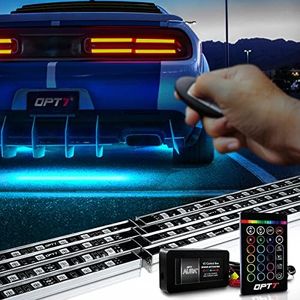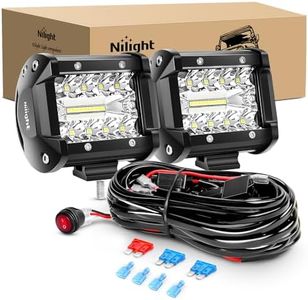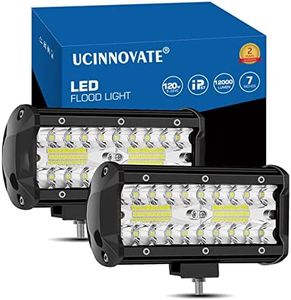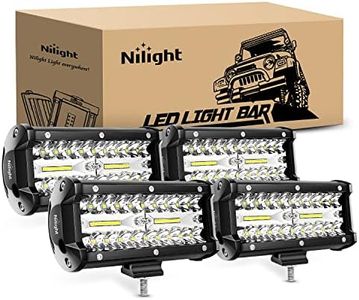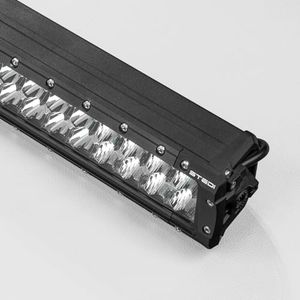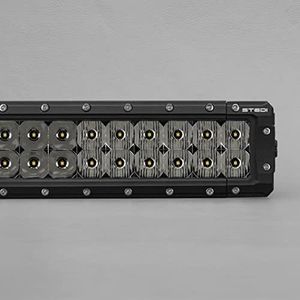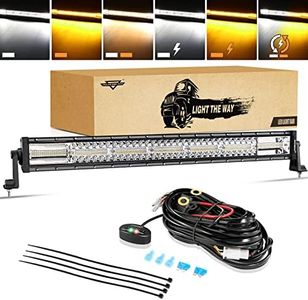We Use CookiesWe use cookies to enhance the security, performance,
functionality and for analytical and promotional activities. By continuing to browse this site you
are agreeing to our privacy policy
10 Best LED Light Bars
From leading brands and best sellers available on the web.Buying Guide for the Best LED Light Bars
When choosing an LED light bar, it's important to think about where and how you plan to use it. Whether it's for off-road vehicles, work sites, your garage, or home decor, the right LED light bar will depend on the brightness you need, how easy it is to install, and how durable it is. Understanding the main specifications will help you decide which product will perform best for your specific situation.Length and SizeThe length and size of an LED light bar refer to its physical dimensions, typically measured in inches. This spec matters because it determines how much area the bar will illuminate and where you can install it. Shorter bars, like those under 12 inches, are ideal for small vehicles, cramped spaces, or detailed tasks. Medium bars, between 12 and 30 inches, work well for most cars, trucks, or work benches. Longer bars, over 30 inches, are best for maximum coverage on large vehicles or wide areas. To pick the right size, measure the space where you plan to install the bar and match it with the area you want to light up.
Brightness (Lumens)Brightness is measured in lumens and shows how much light the bar can produce. Higher lumens mean a brighter light. Low-brightness bars (below 3,000 lumens) are suitable for interior lighting or accent use. Mid-range (3,000 to 10,000 lumens) works well for general outdoor use or moderate off-roading. High-brightness bars (more than 10,000 lumens) are needed for demanding work conditions or extreme visibility for off-road adventures. Choose according to how much light you actually need—too much can be wasteful or blinding, while too little won’t give you enough visibility.
Beam PatternThe beam pattern describes how the light spreads. Common types are spot, flood, or combo. Spot beams concentrate light into a narrow, long-range beam—useful for seeing far ahead, like on highways or on trails. Flood beams spread light out over a wide area, making them better for general visibility close around you. Combo beams offer both spot and flood features for a balance between distance and area coverage. Select a beam pattern based on whether you need to see far away, light up a wide area, or want a mix of both.
Waterproof and Weatherproof Rating (IP Rating)The IP rating tells you how well a light bar can resist water and dust. This is especially important if the bar will be outside or in harsh conditions. Ratings are shown as IP followed by two numbers, such as IP67 or IP68—the higher the numbers, the better the protection. Light bars with lower ratings (like IP65) handle light rain or indoor use. Higher ratings (IP67, IP68) mean they can handle heavy rain, dust, or even being submerged briefly. Choose based on your expected environment—a high rating is a must for outdoor or off-road use.
Power Consumption (Wattage)Power consumption is shown in watts and measures how much electricity the bar uses. Lower wattages use less energy but are usually less bright, while higher wattages offer more brightness but need more power. For small, battery-powered setups or vehicles with limited electrical capacity, low or mid-wattage bars are best. For stationary setups or vehicles with robust power systems, higher wattages are fine. Match the power needs of your bar with the power available in your installation location.
Mounting Options and AdjustabilityThis spec covers the ways you can install and angle the light bar. Some bars come with brackets, sliding mounts, or swiveling features that let you point the light where you need. Fixed mounts are good for simple setups, while adjustable or multi-position mounts are better if you want to change direction or placement easily. Consider where you plan to install the bar and how often you might need to reposition it—if flexibility is important, choose a model with more mounting options.
Color TemperatureColor temperature is measured in Kelvins (K) and affects the look of the light. Lower numbers (around 3,000K) produce warm, yellowish light, which is softer on the eyes and good for comfort or foggy conditions. Higher numbers (over 6,000K) give off a cool, bluish-white light, which is sharper and provides more contrast—ideal for clear visibility at night. If you want comfortable lighting, go for a lower color temperature; for maximum brightness and clarity, especially outdoors at night, choose a higher value.


